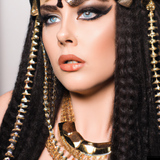Scientists are trying to recreate the perfumes used by ancient civilizations, such as Cleopatra's, using recipes recorded in ancient Egyptian texts and inscriptions on temple walls.
Cleopatra VII, the last ruler of the Ptolemaic dynasty in Egypt, was famous for her love of perfume, and even used it to seduce the Roman general Marc Antony. Plutarch's "Life of Marcus Antonius" describes how Cleopatra, dressed as the goddess Venus, was fanned by cupids as she sailed up the river Cydnus to meet Antony, leaving the riverbanks enveloped in the scents of incense offerings.
After Cleopatra's death in 30 BCE, a book entitled "Cleopatra's Cosmetic" circulated in Egypt, containing recipes for fragrant oils and cleansers. This book provides valuable insight into the perfumery practices of the time, and it is believed that Cleopatra may have used some of these recipes herself.
Perfume-making was an important part of ancient Egyptian culture and religion, as the Egyptians believed that scent played a crucial role in communicating with the gods. Fragrant oils were used in religious ceremonies and to embalm the dead, with some recipes even inscribed on temple walls.
The perfume industry in Egypt flourished under the rule of the Ptolemies, who were known for their love of luxury and extravagance. Today, the techniques used to create ancient Egyptian perfumes remain a mystery, but researchers are working to decode the ancient perfumers' methods by analyzing ancient texts and experimenting with different ingredients and techniques.
Sean Coughlin, a researcher of ancient and medieval thought at the Czech Academy of Sciences, is leading the effort to reproduce the historical recipes. His team is using organic chemistry to determine the process used to make the perfumes. For example, the recipe for Mendesian requires heating oil for 10 days and 10 nights before adding ingredients such as cinnamon and myrrh. The team discovered that heating the oil for an extended period accelerated the process of the oil going rancid, removing any unpleasant smells and ultimately allowing the perfume to last longer.
Perfumes have been used by ancient civilizations for various purposes, such as religious ceremonies, personal hygiene, and as an aphrodisiac. The techniques used by ancient perfumers in Egypt and Greece were innovative and pioneering, with many of their methods still used in modern science today.
In ancient Egypt, perfume-making was considered an art form and a way to communicate with the gods. To create these perfumes, ancient Egyptian perfumers used a wide range of natural ingredients, including flowers, resins, and spices. They extracted essential oils through several methods, including steam distillation and cold pressing. They also used solvents like fat or oil to extract the essential oils from plant material.
Similarly, ancient Greek perfumers also used natural ingredients like flowers, herbs, and spices to create perfumes, but they had a more practical approach, using perfumes primarily for personal hygiene and as an aphrodisiac.
The ancient Greeks were renowned for their use of olive oil as a base for their perfumes. They mixed the oil with aromatic ingredients such as rose petals, lavender, and thyme to create a unique scent. The Greeks also used animal products like musk and ambergris in their perfumes.
Despite the centuries that have passed since the creation of ancient perfumes, researchers are still attempting to decode and reproduce the scents. The techniques used by ancient perfumers have had a profound influence on modern science, with many of their methods still used in the perfume industry today. Through their efforts, these ancient perfumers continue to inspire and fascinate us.

